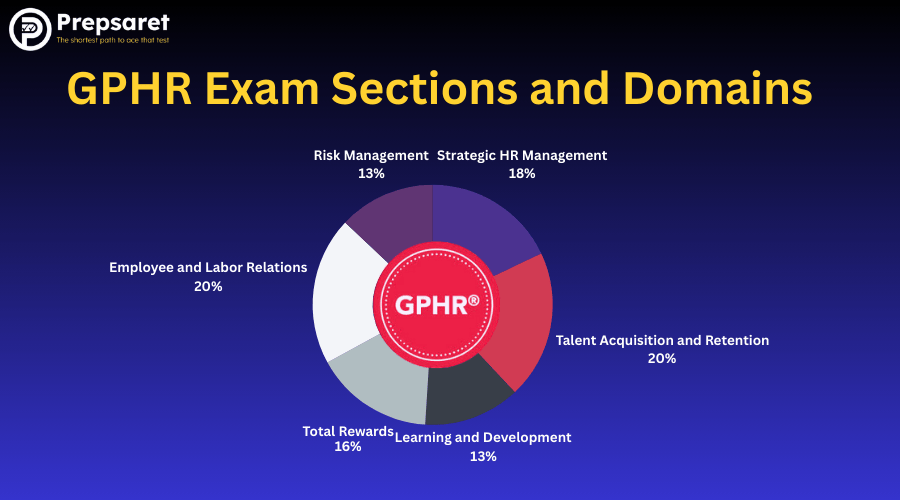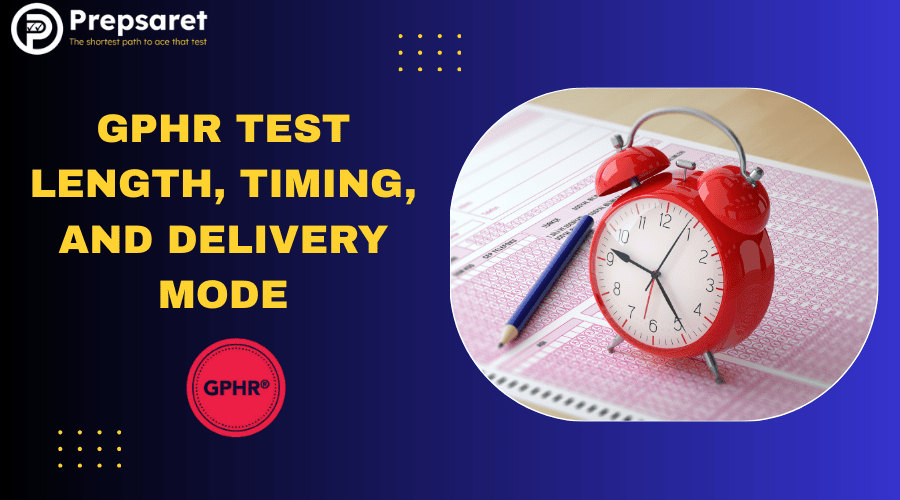If you’re pursuing a career in global human resources, understanding the GPHR exam format and structure is absolutely crucial for your success. The Global Professional in Human Resources (GPHR) certification represents one of the most prestigious credentials in international HR management.
This Human Resource exam is designed for seasoned HR professionals who work in multinational environments and need to demonstrate expertise in global HR practices. Whether you’re managing international teams or developing worldwide HR policies, mastering the exam’s structure will significantly boost your preparation strategy.
At Prepsaret, we’ve helped thousands of professionals navigate this challenging certification by providing comprehensive study materials and practice tests that mirror the actual exam format.
Overview of the GPHR Exam Format and Structure
The GPHR exam format and structure, or GPHR certification exam pattern, is carefully designed to test your competency in global human resources management. Administered by the Human Resource Certification Institute (HRCI), this certification validates your ability to handle complex international HR challenges.
The HRCI GPHR exam structure follows a comprehensive framework that evaluates candidates across multiple domains of global HR expertise. Understanding the Global Professional in Human Resources exam structure is essential because it’s not just another multiple-choice test.
The exam is strategically organized to assess your practical knowledge and decision-making abilities in real-world global HR scenarios. The GPHR exam format and structure encompasses various question types, timing constraints, and content areas that directly reflect the challenges you’ll face as a global HR professional.
The exam’s design philosophy centers around practical application rather than mere theoretical knowledge. This means you’ll encounter questions that simulate actual workplace situations, requiring you to think critically about international labor laws, cultural considerations, and global business practices.
The structured approach ensures that certified professionals can effectively manage HR functions across different countries and cultures.
GPHR Test Blueprint and Content Coverage
The GPHR test blueprint serves as your roadmap to success, outlining exactly what you need to know for the exam. This comprehensive GPHR exam content outline breaks down the certification into specific domains, each carrying different weights and covering distinct aspects of global HR management.
Understanding this blueprint is fundamental to grasping the overall GPHR exam format and structure.
GPHR Exam Syllabus and Domains
The GPHR exam syllabus and domains cover six primary areas that reflect the reality of global HR work:
- Strategic HR Management (18% of exam content)
- Talent Acquisition and Retention (20% of exam content)
- Learning and Development (13% of exam content)
- Total Rewards (16% of exam content)
- Employee and Labor Relations (20% of exam content)
- Risk Management (13% of exam content)
Each domain within the blueprint is carefully weighted based on its importance in global HR practice. The content coverage ensures that you’re tested on contemporary issues like remote work policies, international compensation strategies, and cross-cultural communication challenges.
The blueprint also includes specific knowledge statements and skills that define what a competent global HR professional should possess. By studying in alignment with the GPHR test blueprint, you focus your preparation on the exact skills and topics that will appear in the exam, increasing your chances of success.
GPHR Exam Sections and Domains
The GPHR exam sections and domains are structured to provide a comprehensive assessment of your global HR capabilities. Understanding how the GPHR exam is structured will help you allocate your study time effectively and focus on areas where you need the most improvement.
- Strategic HR Management Domain 18%: Focuses on your ability to develop and implement HR strategies that align with organizational goals across multiple countries. This section tests your knowledge of international business practices, regulatory compliance, and strategic workforce planning.
- Talent Acquisition and Retention 20%: Evaluates your expertise in recruiting, selecting, and retaining talent in global markets. You’ll encounter questions about visa requirements, international recruitment strategies, and cultural considerations in hiring practices.
- Learning and Development 13%: Assesses your ability to design and implement training programs for diverse, multicultural workforces. This includes understanding different learning styles across cultures and developing globally consistent yet locally relevant training initiatives.
- Total Rewards 16%: Examines your knowledge of international compensation and benefits strategies. Questions cover topics like expatriate compensation, local market pricing, and benefits compliance across different countries.
- Employee and Labor Relations 20%: Tests your understanding of international labor laws, union relations, and employee engagement strategies in various cultural contexts.
- Risk Management 13%: Focuses on your ability to identify, assess, and mitigate HR-related risks in global operations, including legal compliance, data protection, and crisis management.
By fully understanding these GPHR exam sections and domains, you can tailor your preparation to address both your strengths and weaknesses, ensuring you meet the demands of the exam’s global scope.
Related Post: How to Pass the SPHR Exam on Your First Attempt
GPHR Question Types and Difficulty Levels
The GPHR question types and topics are designed to challenge your analytical thinking and practical application skills. Unlike basic certification exams, the GPHR multiple-choice questions format includes complex scenario-based questions that require deep understanding of global HR principles.
You’ll encounter three primary question formats:
- Traditional multiple-choice questions that test factual knowledge and basic concepts
- Situational judgment questions that present realistic workplace scenarios requiring you to select the best course of action
- Case study questions that provide detailed business situations and ask you to analyze problems and recommend solutions
The difficulty levels vary throughout the exam, with questions ranging from basic recall to complex analysis and application. Many questions are designed to test your ability to consider multiple factors simultaneously, such as legal requirements, cultural sensitivities, and business objectives when making HR decisions.
The complexity increases as you progress through different domains, with later sections often building upon concepts introduced earlier. This progressive difficulty ensures that only truly competent professionals achieve certification.
GPHR SAMPLE QUESTIONS
1. Traditional Multiple-Choice Questions
Designed to test your factual knowledge and understanding of basic HR principles.
Sample Question:
Which of the following best describes the primary goal of strategic workforce planning in a multinational organization?
A) Reducing annual recruitment costs
B) Aligning talent strategies with long-term business objectives across multiple regions
C) Standardizing compensation plans globally without exceptions
D) Ensuring compliance with domestic labor laws only
Correct answer: B
Why B is correct
- Strategic workforce planning is about matching talent supply to the organization’s long-term business goals across regions — ensuring you have the right people, in the right roles, where the business needs them.
Why the others are wrong
- A (Reducing recruitment costs): Cost reduction might be a byproduct, but it’s not the primary goal. Strategic planning is strategic (alignment), not just cost cutting.
- C (Standardize compensation globally): Standardizing without exceptions ignores local markets, legal requirements, and cost-of-living differences — making it an impractical and risky “primary goal.”
- D (Ensuring compliance with domestic laws only): Too narrow. Multinational planning must consider multiple jurisdictions, cross-border issues, and global strategy — not just one country’s laws.
2. Situational Judgment Questions
Present realistic workplace scenarios where you must choose the most effective response.
Sample Question:
Your company is expanding into a country with strong labor union protections. Which initial step should HR leadership take to ensure smooth integration?
A) Implement uniform HR policies across all global locations
B) Engage local legal experts to align company policies with national labor regulations
C) Delay hiring until union negotiations conclude
D) Rely on the company’s existing global compliance framework
Correct answer: B
Why B is correct
- Local legal experts provide jurisdiction-specific guidance (labor law, bargaining norms, union practices). They help adapt policies to avoid violations and reduce operational risk — a prudent first step.
Why the others are wrong
- A (Uniform policies): Risky — uniform policies often conflict with local laws and labor norms.
- C (Delay hiring): Operationally harmful and usually unnecessary; you can proceed if you do proper legal due diligence and stakeholder engagement.
- D (Rely on existing framework): A global framework is a starting point but rarely covers local union specifics. You need local adaptation.
Try Out More: Free GPHR Practice Test
GPHR Test Length, Timing, and Delivery Mode
The GPHR test length and timing are crucial factors in your preparation strategy. Before you schedule your exam, it’s important to understand how the GPHR is structured and delivered. Knowing the number of questions, the time you’ll have, and the testing environment can help you plan your study pace, practice under realistic conditions, and feel confident on exam day.
GPHR Test Length
The GPHR exam consists of 140 questions that must be completed within a 3-hour time limit. These include both scored questions and unscored pilot questions used by HRCI for future exam development.
GPHR Test Timing
The time allocation gives you about 90 seconds per question on average. Some factual questions will take less time, while complex scenario-based questions may require more. The exam includes a 15-minute optional break after approximately 2 hours of testing, allowing you to refresh and maintain focus.
Find Out: How Do I Schedule My PHR Exam?
GPHR Test Delivery Mode
The GPHR computer-based testing format is delivered exclusively through Pearson VUE testing centers worldwide. This standardized delivery method ensures consistent testing conditions regardless of your location. The computer-based format allows for features like:
- Review and mark capabilities for questions you want to revisit
- On-screen calculator for compensation and benefits calculations
- Countdown timer to track your remaining time
- Tutorial section to get familiar with the interface before starting
Find Out: Can I Take The PHR Exam Online?
GPHR Scoring and Grading
Understanding the GPHR scoring and grading method helps set realistic expectations and guides your preparation approach. The GPHR exam number of questions includes both scored and unscored items, but you won’t know which questions count toward your final score.
HRCI uses scaled scoring, which means your raw score (number of correct answers) is converted to a scaled score ranging from 100 to 700. The minimum passing score is 500, which typically corresponds to correctly answering approximately 60-65% of the scored questions.
GPHR Key Scoring Rules
- No penalty for wrong answers – you should attempt every question
- Equal weighting for all scored questions regardless of difficulty
- Domain-based feedback provided on your score report
- Pass/fail notification available immediately upon completion
The scaled scoring system accounts for slight variations in exam difficulty across different test forms. This ensures fairness regardless of which specific questions you receive on test day.
Comparing GPHR with Other HRCI Exams
When considering HRCI exam options, it’s helpful to understand how the GPHR compares to other certifications like SPHR and PHR. Understanding what are the SPHR exam test specifications and the PHR exam content outline 2025 can help you choose the right certification path.
| Certification | Focus Area | Questions | Time Limit | Experience Required |
| GPHR | Global HR Management | 165 | 4 hours | 2 + years global |
| SPHR | Senior-level HR | 175 | 4 hours | 4 + years |
| PHR | Mid-level HR | 175 | 4 hours | 1 + year |
The PHR exam content outline 2024 and current 2025 version show evolution in HR practices, but the GPHR maintains its focus on international expertise. While how many questions are on the PHR exam (175) exceeds the GPHR count, the GPHR’s specialized content makes it particularly challenging.
Unlike domestic HR certifications, the GPHR requires understanding of:
- International labor laws and regulations
- Cross-cultural management principles
- Global mobility and expatriate management
- Multi-country compliance requirements
- International compensation strategies
Tip: You can explore tools like the Free PHR Practice Test to better understand question formats—especially helpful if you’re deciding between certifications.
Find Out: GPHR vs SPHR
GPHR Preparation Insights and Resources
Effective preparation for the GPHR requires understanding how the GPHR exam format and structure aligns with available study resources. While some candidates seek SPHR practice test PDF materials, GPHR-specific resources are essential due to the exam’s unique international focus.
At Prepsaret, we provide comprehensive study materials designed specifically for the GPHR exam. Our prep course includes:
-
Exam-simulated practice tests that mirror the real testing experience.
-
Domain-specific question banks to help you target and strengthen weak areas.
-
Detailed answer explanations to deepen understanding and reinforce learning.
-
Performance tracking tools so you can monitor progress over time.
-
Mobile accessibility, allowing you to study anytime, anywhere.
Successful candidates typically dedicate 3–6 months of preparation, with about 10–15 hours of study each week. The most effective study plan combines:
-
Thorough content review using official HRCI materials.
-
Regular practice testing to get comfortable with exam formats.
-
Case study analysis to strengthen scenario-based problem-solving.
-
Ongoing international HR research to stay updated on global trends.
With Prepsaret’s resources, candidates are better equipped to approach the GPHR exam with confidence.
Remember: Understanding the exam structure is just as important as knowing the content. Familiarizing yourself with question types, timing, and delivery format will boost your confidence and performance on test day.
GPHR Exam Format and Structure: FAQs
What Is the Pass Rate for the GPHR Exam?
HRCI doesn't publish exact pass rates, but the GPHR typically has a lower pass rate than domestic HR certifications due to its specialized international content and rigorous standards.
How Is the PHR Exam Structured?
The PHR exam consists of 175 questions covering six domains of HR knowledge, delivered in a computer-based format over four hours, similar to the GPHR but with domestic rather than global focus.
What Is the Full Form of GPHR Certification?
GPHR stands for Global Professional in Human Resources, representing HRCI's premier certification for international HR professionals.
What Is the Easiest HR Certification to Get?
The aPHR (Associate Professional in Human Resources) is generally considered the most accessible HR certification, designed for entry-level professionals with less experience requirements.
How Hard Is the HR Certification Exam?
HR certification exam difficulty varies by level and specialization. The GPHR ranks among the most challenging due to its international scope, while entry-level certifications like aPHR are more accessible for new professionals.
Final Thoughts on Mastering the GPHR Exam
Mastering the GPHR exam format and structure is your foundation for certification success, but it’s only the beginning of your journey. The exam’s comprehensive design reflects the complex reality of global HR management, where you must balance legal compliance, cultural sensitivity, and business objectives across multiple countries.
By thoroughly understanding each domain, question type, and timing constraint, you’re positioning yourself not just to pass the exam, but to excel as a global HR professional. At Prepsaret, we’re committed to providing the most accurate and comprehensive practice materials available, ensuring you’re fully prepared for every aspect of this challenging certification.




